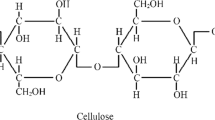Abstract
Nanocellulose fibers were prepared using physico-chemical treatment of rice straw, characterized and explored for the remediation of some toxic metals from wastewater. Nanocellulose fibers were found to have long rod-like elongated nano fibrillated morphology with average grain size 6 nm. The prepared nanocellulose fibers (0.5 g) in batch experiments showed removal efficiency of 9.7 mg/g Cd (II), 9.42 mg/g Pb(II), and 8.55 mg/g Ni (II) ions from 25 mg/l of metal solution. The sorption process fitted well to both Freundlich and Langmuir isotherms [(R2) Cd (II): 0.92, 0.95; Pb(II): 0.94, 0.97 and Ni (II): 0.97, 0.98]. The regeneration studies signify that nanocellulose fibers can be successively used up to three cycles of regeneration. Nanotech reinforcement to native cellulose significantly enhanced metal removal efficiency compared to rice straw and cellulose fibers, provides new avenues as cost effective, environment-friendly green remediation or can be used as a pre-treatment step prior to chemical decontamination methods for toxic metals.










Similar content being viewed by others
References
Bondeson D, Mathew A, Oksman K (2006) Optimization of the isolation of nanocrystals from microcrystalline cellulose by acid hydrolysis. Cellulose 13:171–180
Colvin VL (2003) The potential environmental impact of engineered nanomaterials. Nat Biotechnol 10:1166–1170
Czaja WK, Young DJ, Kawecki M, Brown RM (2007) The future prospects of microbial cellulose in biomedical applications. Biomacromolecules 8:1–12
Dhermendra KT, Behari J, Prasenjit S (2008) Application of nanoparticles in waste water treatment. WASJ 3(3):417–433
Diallo MS, Christie S, Swaminathan P, Johnson JH, Goddard WA (2005) Dendrimer enhanced ultra-filtration recovery of Cu (II) from aqueous solutions using Gx-NH2-PAMAM dendrimers with ethylene diamine core. Environ Sci Technol 39:1366–1377
Goyal P, Sharma P, Srivastava S, Srivastava MM (2008a) Saraca indica leaf powder for decontamination of lead: removal, recovery, adsorbent characterization and equilibrium modeling. Int J Environ Sci Technol 5:27–34
Goyal P, Srivastava MM, Srivastava S (2008b) Ficus religiosa leaf powder: a green economical biomaterial for the removal of Cd (II) ions from aqueous solution. J Nucl Agr Biol 36(1&2):16–27
Iqbal M, Saeed A, Akhtar N (2002) Petiolar felt sheath of palm: a new biosorbent for the removal of heavy metals from contaminated water. Bioresour Technol 81(2):151–153
Ishikawa A, Okano T, Sugiyama J (1997) Fine structure and tensile properties of ramie fibres in the crystalline form of cellulose I, II, III1 and IV1. Polymer 38((2):463–468
Kamel S (2007) Nanotechnology and its applications in lignocellulosic composites, a mini review. eXPRESS Polym Lett 1(9):546–575
Kardam A, Goyal P, Arora JK, Raj KR, Srivastava S (2009) Novel biopolymeric material: synthesis and characterization for decontamination of cadmium from wastewater. Natl Acad Sci Lett 32:179–181
Kardam A, Raj KR, Arora JK, Srivastava S (2010) Artificial neural network modeling for sorption of cadmium from aqueous system by shelled Moringa oleifera seed powder as an agricultural waste. JWARP 2:339–344
Kardam A, Raj KR, Arora JK, Srivastava S (2011) ANN modeling on predictions of Biosorption efficiency of zea mays for the removal of Cr(III) and Cr(VI) from waste water. Int J Math Trends Technol 2(1):23–29
Karn B, Kuiken T, Otto M (2009) Nanotechnology and in situ remediation: a review of the benefits and potential risks. Environ Health Perspect 117(12):1823–1831
Klemm D, Heublein B, Fink HP, Bohn A (2005) Cellulose: fascinating biopolymer and sustainable raw material. Angew Chem Int Ed 44:3358–3393
Lo′pez-Rubio A, Lagaron JM, Ankerforsx T, Lindstro¨m T, Nordqvist D, Mattozzi A, Hedenqvist MS (2007) Enhanced film forming and film properties of amylopectin using micro-fibrillated cellulose. Carbohyd Polym 68:718–727
Ma H, Burger C, Hsiao BS, Chu B (2011) Ultra-fine cellulose nanofibers: new nano-scale materials for water purification. J Mater Chem 21:7507–7510
Ma H, Hsiao BS, Chu B (2012) Ultrafine cellulose nanofibers as efficient adsorbents for removal of UO2 2+ in water. ACS Macro Lett 1:213–216
Nel A, Xia T, Madler L, Li N (2006) Toxic potential of materials at the nanolevel. Science 311:622–627
Paul GT, Richard LJ (2006) Nanotechnologies for environmental cleanup. Nanotoday 1(2):44–48
Rajawat DS, Kardam A, Srivastava S, Satsangi SP (2013) Nanocellulosic fibers-modified carbon paste electrode for ultra trace determination of Cd (II) and Pb(II) in aqueous solution. Environ Sci Pollut Res 20:3068–3076
Rickerbya DG, Morrison M (2007) Nanotechnology and the environment: a European perspective. Sci Technol Adv Mater 8:19–24
Sain M, Oksman K (2006) Cellulose nanocomposites-processing, characterization and properties volume 938 of ACS symposium series. Am Chem Soc, Washington, DC, p 2006
Samir MA, Alloin F, Dufresne A (2005) Review of recent research into cellulosic whiskers, their properties and their application in nanocomposites field. Biomacromolecules 6:612–626
Sato A, Wang R, Ma H, Hsia BS, Chu B (2011) Novel nanofibrous scaffolds for water filtration with bacteria and virus removal capability. J Electron Microsc 60:201–209
Sharma P, Kumari P, Srivastava MM, Srivastava S (2006) Removal of cadmium from aqueous system by shelled Moringa oleifera seed powder. Bioresour Technol 97(2):299–305
Shimazaki Y, Miyazaki Y, Takezawa Y, Nogi M, Abe K, Ifuku S, Yano H (2007) Excellent thermal conductivity of transparent cellulose nanofiber/epoxy resin nanocomposites. Biomacromolecules 8:2976–2978
Silva RV, Aquino EMF (2008) Curaua fiber: a new alternative to polymeric composites. J Reinf Plast Comp 27(1):103–112
Siro I, Plackett D (2010) Microfibrillated cellulose and new nanocomposite materials: a review. Cellulose 17:459–494
Visakh PM, Thomas S (2010) Preparation of bionanomaterials and their polymer nanocomposites from waste and biomass. Waste Biomass Valorization 1:121–134
Wiesner MR, Lowry GV, Alvarez P, Dionysiou D, Biswas P (2006) Assessing the risks of manufactured nanomaterials. Environ Sci Technol 40:4336–4345
Acknowledgments
The authors gratefully acknowledge Prof. V.G. Das, Director, and Prof. L.D. Khemani, Head, Department of Chemistry, Dayalbagh Educational Institute, Agra, India for providing the necessary research facilities.
Author information
Authors and Affiliations
Corresponding author
Rights and permissions
About this article
Cite this article
Kardam, A., Raj, K.R., Srivastava, S. et al. Nanocellulose fibers for biosorption of cadmium, nickel, and lead ions from aqueous solution. Clean Techn Environ Policy 16, 385–393 (2014). https://doi.org/10.1007/s10098-013-0634-2
Received:
Accepted:
Published:
Issue Date:
DOI: https://doi.org/10.1007/s10098-013-0634-2




